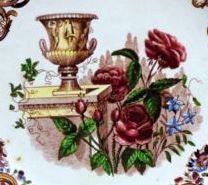To achieve proper printing results, choose 'Portrait Orientation' and 'Fit to Page' options in your print settings.
 |
|
Copeland & Garrett (Maker) |
Following the death of his father Josiah Spode II in 1827, Josiah Spode III kept a watching brief over the Spode works. Incapacitated by an unfortunate accident at the factory in 1802, he was unable to engage in the day to day business. On his death in 1829 the executors administered a long standing agreement which saw William Taylor Copeland running the London retail business as well as holding one quarter share in the factory. At the termination of the agreement on March 1, 1833, Copeland purchased the remaining shares in the factory and the London business. Being greatly involved in in politics, in developing art school education, and living the life of a well to do London gentleman, Copeland engaged one of his senior London employees as a partner and Thomas Garrett took responsibility for overseeing the smooth running of the Stoke factory. The factory grew in size during this partnership and the production of porcelain, earthenware, and stoneware continued. New shapes were added and patterns and designs were influenced by the rococo revival that dominated fashions in the 1830s. Copeland & Garrett's bone china and felspar porcelain attracted the attention of highest echelons of society, and after her Majesty Queen Victoria's accession to the throne in 1837, she acquired wares for both Buckingham Palace and Windsor Castle. Despite the prominence of their porcelain productions they continued to make earthenware in even larger quantities with markets at home and abroad. Among their finest productions are the printed patterns some of which were traditional designs from Spode's time and other newer patterns introduced for the contemporary market. After 14 years, in 1847, the partnership was dissolved and Garrett returned to London while Copeland continued to run the business. To see printed wares produced by Copeland & Garrett click here. |
|
http://printedbritishpotteryandporcelain.com/who-made-it/copeland-garrett-maker |

